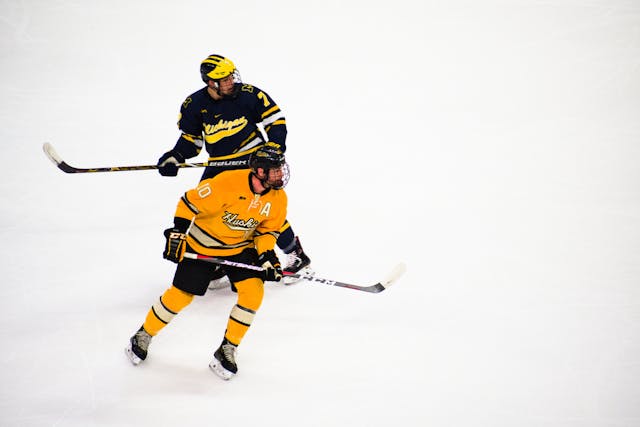Get ready to hit the ice with GertieBlu! If you’ve ever wondered about the exhilarating world of ice hockey, you’re in the right place. Ice hockey is a fast-paced, intense sport that combines strategy, skill, and teamwork. Whether you’re new to the game or just curious, this guide will introduce you to the basics of how to play ice hockey and what makes it such a thrilling experience.
The Basics of Ice Hockey
Ice hockey is played on a rectangular rink of ice with two teams, each consisting of six players: three forwards, two defensemen, and a goaltender. The objective is simple—score more goals than the opposing team by shooting a small rubber puck into the opponent’s net. But achieving that goal is anything but simple!
The Rink
The ice hockey rink is divided into three zones:
- Defensive Zone: The area around your team’s goal.
- Neutral Zone: The middle section of the rink.
- Offensive Zone: The area around the opponent’s goal.
Each team aims to move the puck from their defensive zone through the neutral zone and into the offensive zone, where they can attempt to score.
The Players
- Forwards: Usually the primary offensive players. They consist of a center and two wingers. The center takes face-offs and typically has a playmaking role, while the wingers focus on scoring goals.
- Defensemen: Their main role is to protect their team’s goal by blocking shots, clearing the puck from the defensive zone, and supporting the forwards in offensive plays.
- Goaltender (Goalie): The last line of defense. The goalie’s job is to stop the puck from entering the net, using any part of their body or stick.

Equipment You Need
Safety is key in ice hockey, so players wear protective gear including:
- Helmet with a cage or visor
- Shoulder pads and elbow pads
- Hockey gloves to protect the hands
- Pants (breezers) and shin guards for leg protection
- Skates designed specifically for ice hockey
- Stick for handling the puck and shooting
- Mouthguard to protect teeth
- Jersey with team colors
Goalies also wear additional padding, including a chest protector, leg pads, and a blocker and catching glove.
How to Play
- Face-Offs
- Each period begins with a face-off at center ice, and additional face-offs occur after each stoppage of play. The referee drops the puck between the sticks of two opposing players who attempt to gain control of it.
- Skating
- Strong skating skills are crucial. Players must be able to start, stop, and turn quickly while maintaining balance and control over the puck.
- Stickhandling
- This involves controlling the puck with the stick while maneuvering around opponents. Good stickhandling allows a player to keep possession of the puck and create scoring opportunities.
- Passing
- Hockey is a team game, and effective passing is key to advancing the puck and setting up plays. Players pass the puck using their sticks, aiming to keep it away from opponents and toward teammates in better positions.
- Shooting
- There are several types of shots in hockey, including wrist shots, slap shots, and backhand shots. The goal is to shoot the puck past the goalie and into the net.
- Defense
- Defensive play is just as important as offense. Defensemen work to block shots, intercept passes, and clear the puck from the defensive zone to prevent the opposing team from scoring.
- Positioning
- Hockey is a game of positioning. Players must be aware of their location on the ice and where their teammates and opponents are. Good positioning helps in both attacking and defending, ensuring that the team maintains control of the puck and limits the opponent’s chances.
The Flow of the Game
Ice hockey is played in three periods, each lasting 20 minutes, with intermissions between periods. The clock stops when the puck is not in play, making for intense, fast-paced action. Players frequently switch out, or “line changes,” to stay fresh throughout the game.

What Makes Hockey Unique?
One of the most exciting aspects of hockey is its physicality. Body checking, where a player uses their body to knock an opponent off the puck, is a legal and strategic part of the game. However, it’s crucial to play within the rules to avoid penalties.
Speaking of penalties, when a player breaks a rule, they might be sent to the penalty box, leaving their team short-handed (with fewer players on the ice). This gives the opposing team a power-play advantage, increasing their chances of scoring.
Why You Should Try Ice Hockey
Ice hockey isn’t just a game; it’s a community. The camaraderie among players, the adrenaline of the game, and the joy of scoring a goal make hockey a sport like no other. It’s also a fantastic way to stay fit, improve coordination, and develop teamwork skills.
Whether you’re playing on a frozen pond or a professional rink, the thrill of ice hockey is unmatched. So, lace up your skates, grab your stick, and hit the ice. The game is fast, the competition fierce, and the experience unforgettable.
Thanks for reading GertieBlu’s guide to ice hockey! If you’re interested to learn more or explore other exciting sports, be sure to check back regularly for new posts. There’s always something new to discover and enjoy in the world of sports!
See you on the ice, GertieBlu









